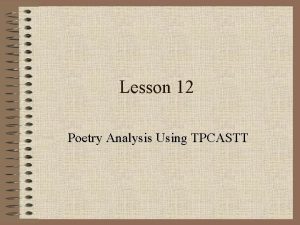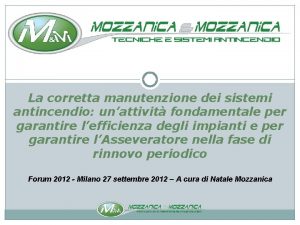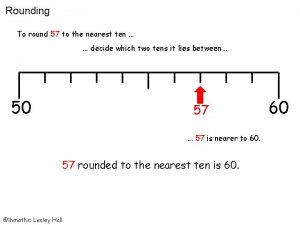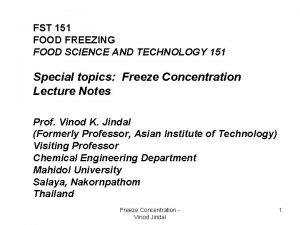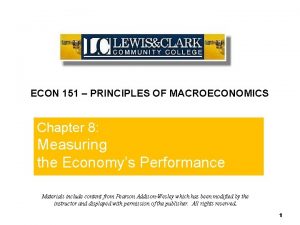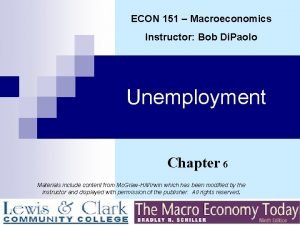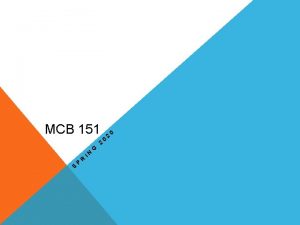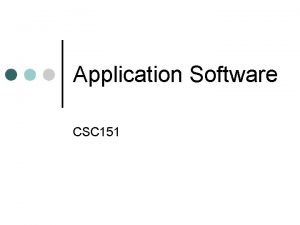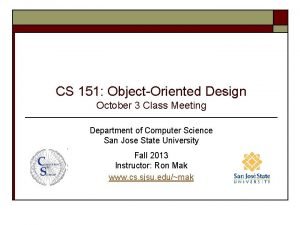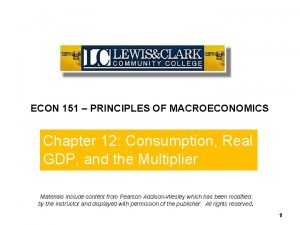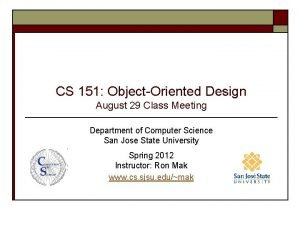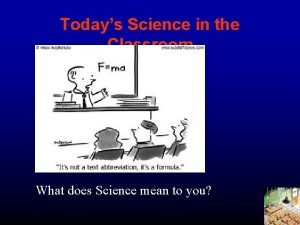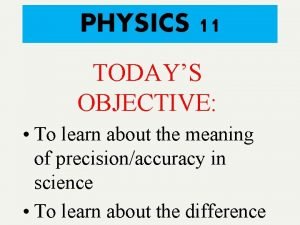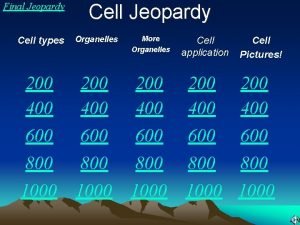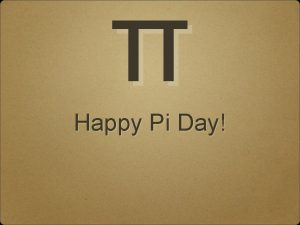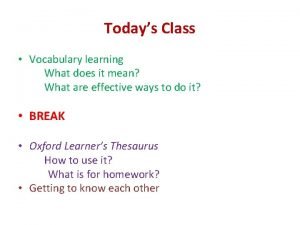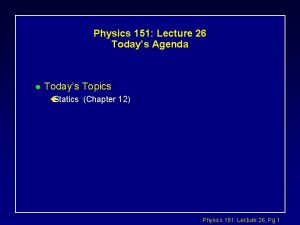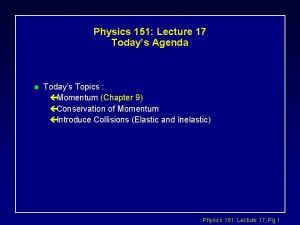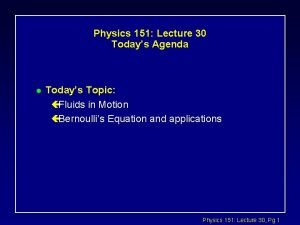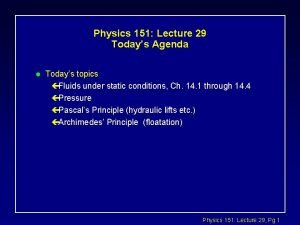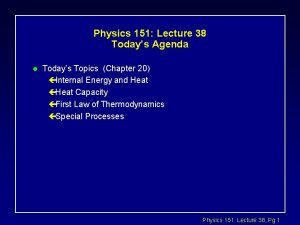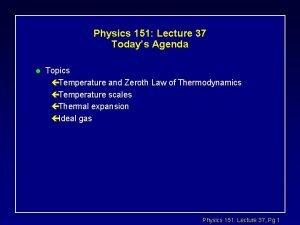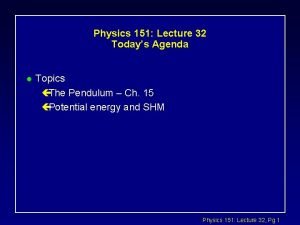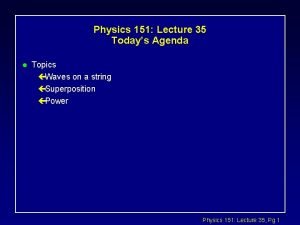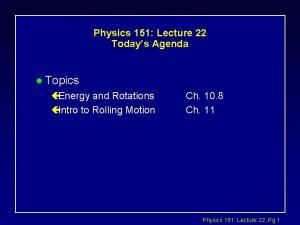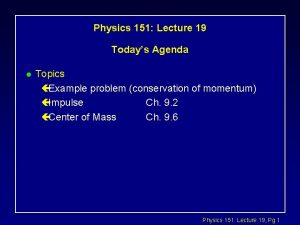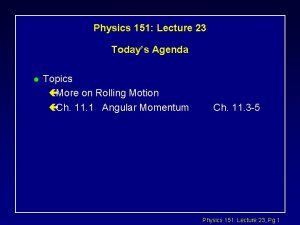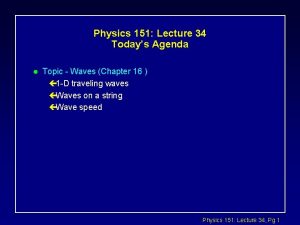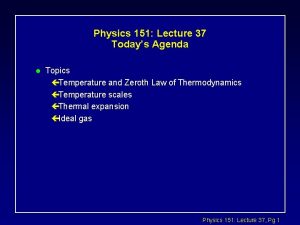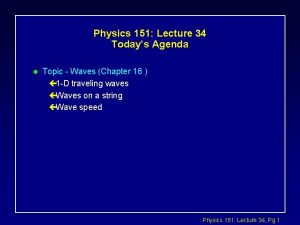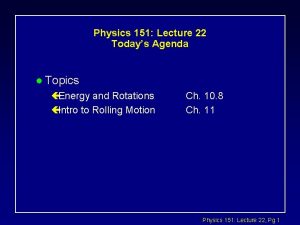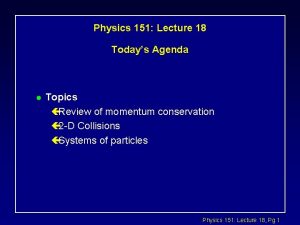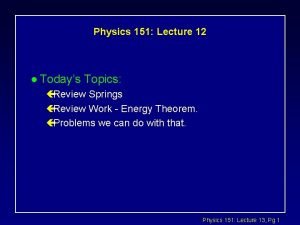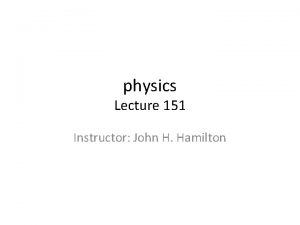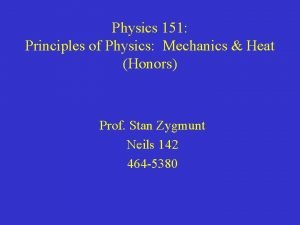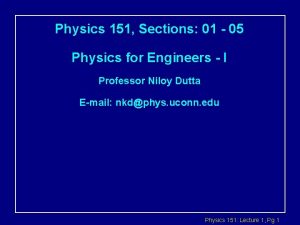Physics 151 Lecture 25 Todays Agenda l Todays





































- Slides: 37

Physics 151: Lecture 25 Today’s Agenda l Today’s Topics: çFinish Chapter 11 çStatics (Chapter 12) Physics 151: Lecture 25, Pg 1

Lecture 25, Act 3 l A particle whose mass is 2 kg moves in the xy plane with a constant speed of 3 m/s along the direction r = i + j. What is its angular momentum (in kg · m 2/s) relative to the origin? a. 0 k b. 6 (2)1/2 k c. – 6 (2)1/2 k d. 6 k e. – 6 k Physics 151: Lecture 25, Pg 2

See text: Ex. 11 Example: Throwing ball from stool l A student sits on a stool which is free to rotate. The moment of inertia of the student plus the stool is I. She throws a heavy ball of mass M with speed v such that its velocity vector passes a distance d from the axis of rotation. çWhat is the angular speed F of the student-stool system after she throws the ball ? M v F I top view: before See example 13 -9 d I after Physics 151: Lecture 25, Pg 3

See text: 11. 6 Gyroscopic Motion. . . l l Suppose you have a spinning gyroscope in the configuration shown below: If the left support is removed, what will happen ? çThe gyroscope does not fall down ! pivot g Physics 151: Lecture 25, Pg 4

See text: 11. 6 Gyroscopic Motion. . . l . . . instead it precesses around its pivot axis ! l This rather odd phenomenon can be easily understood using the simple relation between torque and angular momentum we derived in a previous lecture. pivot Physics 151: Lecture 25, Pg 5

See text: 11. 6 Gyroscopic Motion. . . l l The magnitude of the torque about the pivot is = mgd. The direction of this torque at the instant shown is out of the page (using the right hand rule). çThe change in angular momentum at the instant shown must also be out of the page! d L pivot mg Physics 151: Lecture 25, Pg 6

See text: 11. 6 Gyroscopic Motion. . . l Consider a view looking down on the gyroscope. çThe magnitude of the change in angular momentum in a time dt is d. L = Ld. çSo where is the “precession frequency” L(t) d. L top view d pivot L(t+dt) Physics 151: Lecture 25, Pg 7

See text: 11. 6 Gyroscopic Motion. . . l So l In this example = mgd and L = I : l The direction of precession is given by applying the right hand rule to find the direction of and hence of d. L/dt. d L pivot mg Physics 151: Lecture 25, Pg 8

Lecture 24, Act 1 Statics Suppose you have a gyroscope that is supported on a gymbals such that it is free to move in all angles, but the rotation axes all go through the center of mass. As pictured, looking down from the top, which way will the gyroscope precess? (a) clockwise (b) counterclockwise (c) it won’t precess l Physics 151: Lecture 25, Pg 9

Lecture 24, Act 1 Statics Remember that = t/L. So what is t? t=rx. F r in this case is zero. Why? Thus W is zero. It will not precess. At All. Even if you move the base. This is how you make a direction finder for an airplane. l Answer (c) it won’t precess Physics 151: Lecture 25, Pg 10

See text: 10. 3 Summary: Comparison between Rotation and Linear Motion Angular Linear = x / R x = v / R v = a / R a Physics 151: Lecture 25, Pg 11

Comparison Kinematics Angular Linear Physics 151: Lecture 25, Pg 12

Comparison: Angular Linear I = Si mi ri 2 = r x F = I L = r x p = Dynamics I m F=am p = mv W = F • x K = WNET Physics 151: Lecture 25, Pg 13

See text: 12. 1 -3 Statics (Chapter 12) l As the name implies, “statics” is the study of systems that don’t move. çLadders, sign-posts, balanced beams, buildings, bridges, etc. . . l Example: What are all of the forces acting on a car parked on a hill ? y x N f mg Physics 151: Lecture 25, Pg 14

See text: 12. 1 -3 Car on Hill l l Use Newton’s 2 nd Law: FTOT = MACM = 0 Resolve this into x and y components: x: f - mg sin = 0 f = mg sin y: N - mg cos = 0 y x N f N= mg cos mg Physics 151: Lecture 25, Pg 15

Example 1 l The diagrams below show forces applied to an equilateral triangular block of uniform thickness. In which diagram(s) is the block in equilibrium? l a. b. c. d. e. l l A B C D A and F F F 2 F F F F Physics 151: Lecture 25, Pg 16

See text: 12. 1 -3 Statics: Using Torque l l Now consider a plank of mass M suspended by two strings as shown. We want to find the tension in each string: First use T 1 T 2 T 1 + T 2 = Mg l This is no longer enough to solve the problem ! ç 1 equation, 2 unknowns. L/2 L/4 Mg l We need more information !! M x cm y x Physics 151: Lecture 25, Pg 17

See text: 12. 1 -3 Using Torque. . . l We do have more information: çWe know the plank is not rotating. ç TOT = I = 0 T 1 T 2 M x cm L/2 l l L/4 The sum of all torques is zero. This is true about any axis we choose ! Mg y x Physics 151: Lecture 25, Pg 18

See text: 12. 1 -3 Using Torque. . . l Choose the rotation axis to be along the z direction (out of the page) through the CM: l The torque due to the string T 1 on the right about this axis is: T 2 M x cm L/2 l The torque due to the string on the left about this axis is: L/4 Mg Gravity exerts no torque about CM y x Physics 151: Lecture 25, Pg 19

Using Torque. . . l Since the sum of all torques must be 0: T 1 T 2 M x cm We already found that T 1 + T 2 = Mg L/2 L/4 Mg y x Physics 151: Lecture 25, Pg 20

See text: 12. 1 -3 Approach to Statics: l In general, we can use the two equations to solve any statics problems. l When choosing axes about which to calculate torque, we can be clever and make the problem easy. . Physics 151: Lecture 25, Pg 21

Lecture 25, Act 2 Statics l A 1 kg ball is hung at the end of a rod 1 m long. The system balances at a point on the rod 0. 25 m from the end holding the mass. çWhat is the mass of the rod ? (a) 0. 5 kg (b) 1 kg (c) 2 kg 1 m 1 kg Physics 151: Lecture 25, Pg 22

Lecture 25, Act 2 Solution A l The total torque about the pivot must be zero. l The center of mass of the rod is at its center, 0. 25 m to the right of the pivot. l Since this must balance the ball, which is the same distance to the left of the pivot, the masses must be the same ! same distance m. ROD = 1 kg X 1 kg CM of rod Physics 151: Lecture 25, Pg 23

Lecture 25, Act 2 Solution B l Since the system is not rotating, the x-coordinate of the CM must be the same as the pivot. l The center of mass of the rod is at its center, 0. 25 m to the right of the pivot. l Since the CM of the ball is 0. 25 m to the left of the pivot, the mass of the rod must be 1 kg to make x. CM = 0. -. 25 m 1 kg m. ROD = 1 kg . 25 m X CM of rod x Physics 151: Lecture 25, Pg 24

See text: Ex. 12. 3 Example Problem: Hanging Lamp l Your folks are making you help out on fixing up your house. They have always been worried that the walk around back is just too dark, so they want to hang a lamp. You go to the hardware store and try to put together a decorative light fixture. At the store you find a bunch of massless string (kind of a surprising find? ), a lamp of mass 2 kg, a plank of mass 1 kg and length 2 m, and a hinge to hold the plank to the wall. Your design is for the lamp to hang off one end of the plank and the other to be held to a wall by a hinge. The lamp end is supported by a massless string that makes an angle of 30 o with the plank. (The hinge supplies a force to hold the end of the plank in place. ) How strong must the string and the hinge be for this design to work ? Physics 151: Lecture 25, Pg 25

See text: Ex. 12. 3 Example: Hanging Lamp 1. You need to solve for the forces on the string and the hinge Use statics equations. m L hinge M Physics 151: Lecture 25, Pg 26

See text: Ex. 12. 3 Example: Hanging Lamp 1. You need to solve for T and components of FH. Use SF = 0 in x and y. Use St = 0 in z. T FHx m L/2 Mg FHy L/2 mg Physics 151: Lecture 25, Pg 27

See text: Ex. 12. 3 Hanging Lamp. . . 3. First use the fact that x: y: l in both x and y directions: y T cos - Fx = 0 T sin + Fy - Mg - mg = 0 x Now use in the z direction. ç If we choose the rotation axis to be through the hinge then the hinge forces Fx and Fy will not enter into the torque equation: T Fy m L/2 M L/2 Fx mg Mg Physics 151: Lecture 25, Pg 28

See text: Ex. 12. 3 Hanging Lamp. . . 3 (Cont. ) So we have three equations and three unknowns: T cos + Fx = 0 y T sin + Fy - Mg - mg = 0 LMg + (L/2)mg – LTsinf = 0 x Which we can solve to find, T Fy m L/2 M L/2 Fx mg Mg Physics 151: Lecture 25, Pg 29

See text: Ex. 12. 3 Hanging Lamp. . . 4. Put in numbers y x T Fy m L/2 M L/2 Fx mg Mg Physics 151: Lecture 25, Pg 30

See text: Ex. 12. 3 Hanging Lamp. . . 4. Have we answered the question? Well the string must be strong enough to exert a force of 50 N y without breaking. x We don’t yet have the total force the hinge must withstand. T Fy m Buy a hinge that can take more than 43 N L/2 M L/2 Fx mg Mg Physics 151: Lecture 25, Pg 31

Lecture 26, Act 1 Statics l A box is placed on a ramp in the configurations shown below. Friction prevents it from sliding. The center of mass of the box is indicated by a white dot in each case. çIn which cases does the box tip over ? (a) all 1 (b) 2 & 3 (c) 3 only 2 3 Physics 151: Lecture 25, Pg 32

Lecture 26, Act 1 Solution l We have seen that the torque due to gravity acts as though all the mass of an object is concentrated at the center of mass. l Consider the bottom right corner of the box to be a pivot point. l If the box can rotate in such a way that the center of mass is lowered, it will ! Physics 151: Lecture 25, Pg 33

Lecture 26, ACT 1 Solution l We have seen that the torque due to gravity acts as though all the mass of an object is concentrated at the center of mass. l Consider the bottom right corner of the box to be a pivot point. l If the box can rotate in such a way that the center of mass is lowered, it will ! Physics 151: Lecture 25, Pg 34

Lecture 26, Act 1 Addendum l What are the torques ? ? (where do the forces act ? ) switches sign at critical point goes to zero at critical point always zero N f r. G mg g rf f = 0 r. N N Physics 151: Lecture 25, Pg 35

Example 3 l A square of side L/2 is removed from one corner of a square sandwich that has sides of length L. The center of mass of the remainder of the sandwich moves from C to C’. The distance from C to C’ is : Physics 151: Lecture 25, Pg 36

Recap of today’s lecture l Chapter 12 - Statics Physics 151: Lecture 25, Pg 37
 Todays agenda
Todays agenda 01:640:244 lecture notes - lecture 15: plat, idah, farad
01:640:244 lecture notes - lecture 15: plat, idah, farad Agenda sistemica y agenda institucional
Agenda sistemica y agenda institucional Hino 151
Hino 151 Scia antincendio esempio
Scia antincendio esempio Business information management uci
Business information management uci 57 rounded to the nearest ten
57 rounded to the nearest ten 151 food
151 food 1,151,725 bytes
1,151,725 bytes Econ 151
Econ 151 Econ 151
Econ 151 Tổng kết vốn từ 151
Tổng kết vốn từ 151 Chm 151 final exam
Chm 151 final exam Melissa reedy uiuc
Melissa reedy uiuc Software consists of:
Software consists of: Sjsu cs 151
Sjsu cs 151 Item 151
Item 151 Main event management
Main event management Determinants of consumption
Determinants of consumption 118/151
118/151 Cs 151 sjsu
Cs 151 sjsu Apsc 151
Apsc 151 Physics 101 lecture notes pdf
Physics 101 lecture notes pdf Classical mechanics
Classical mechanics Waves pdf
Waves pdf What is a harmonic wave in physics
What is a harmonic wave in physics Atmospheric physics lecture notes
Atmospheric physics lecture notes Phy101 lecture 1
Phy101 lecture 1 University physics with modern physics fifteenth edition
University physics with modern physics fifteenth edition Physics ia ib examples
Physics ia ib examples Why does it happen
Why does it happen Todays science
Todays science Date frui
Date frui Todays objective
Todays objective Organelle that modifies packages and transports
Organelle that modifies packages and transports Todays plan
Todays plan Today's classes
Today's classes Todays class
Todays class
